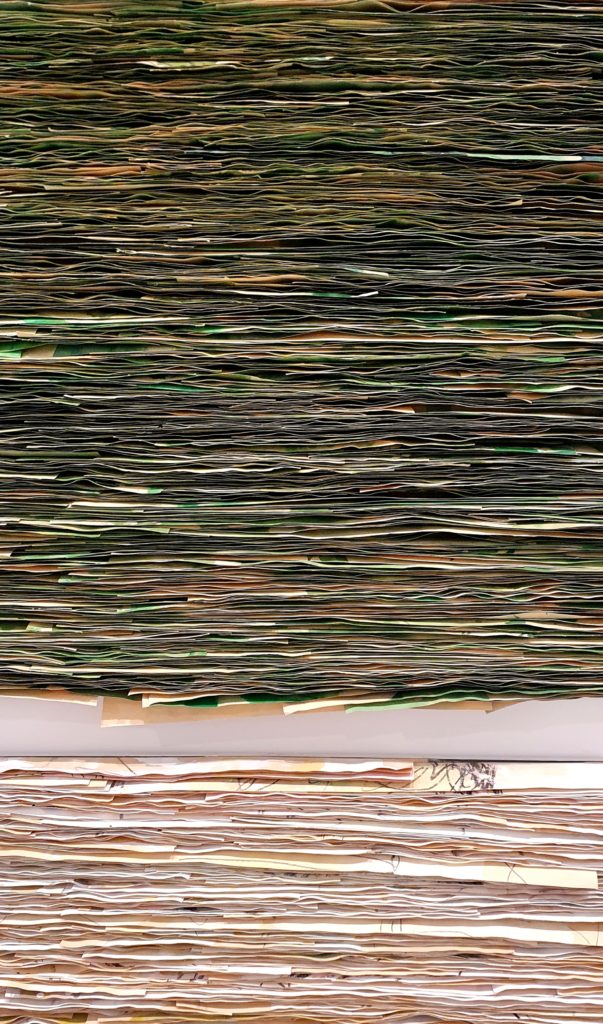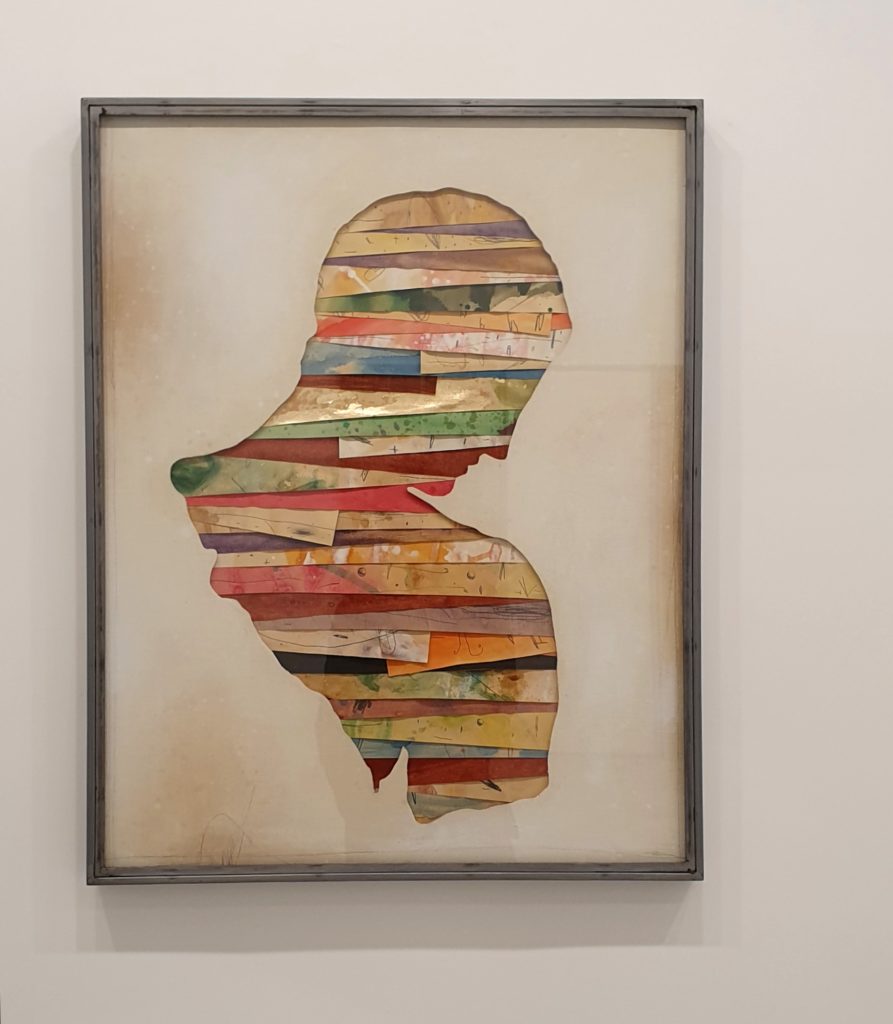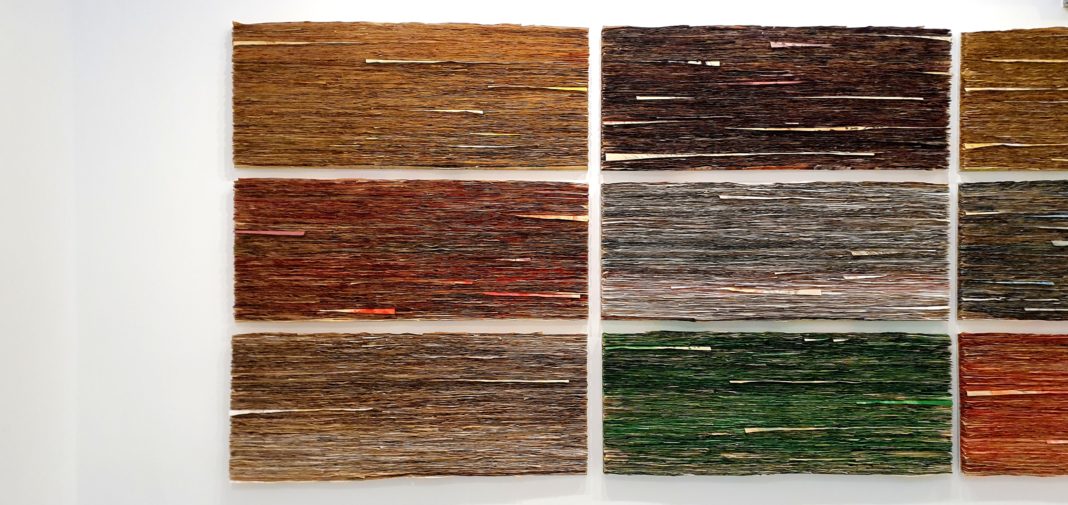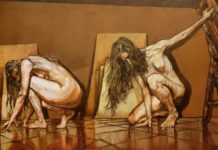“Com’è felice il destino dell’incolpevole vestale! Dimentica del mondo, dal mondo dimenticata. Infinita letizia della mente candida! Accettata ogni preghiera e rinunciato a ogni desiderio.” Alexander Pope

Negli spazi dello Studio Trisorio, tra la Riviera di Chiaia e in via Carlo Poerio per tutto il mese di marzo sarà possibile visitare la personale di Umberto Manzo, artista napoletano profeta in patria.
Opere sue infatti possono essere ammirate all’aeroporto di Capodichino, nella stazione Quattro Giornate della linea 1 della metropolitana partenopea, tra le più belle del mondo, negli importanti musei cittadini di Capodimonte e al Madre.
Manzo, classe 1960 è riuscito nell’intento di sfatare la locuzione latina forse perché proprio come Napoli l’artista lavora ed emerge per stratificazione, sovrapposizione di materiali che vanno a formare opere dal sapore antico che si affacciano sulla contemporaneità, come camminare nel centro storico seguendo cartine digitali.
Nello studio Trisorio, dove Manzo ha inaugurato agli inizi di febbraio, ci accoglie una grande installazione formata da 15 pannelli orizzontali che vanno a sposarsi in un’unica opera. Un raccoglitore della memoria, tema da sempre caro all’artista. Quindici contenitori nati dalla sovrapposizione di migliaia di fogli colorati. Disegni, schizzi, pensieri impressi su carte e vari materiali con tecniche diverse, tagliati e assemblati che vanno a formare paesaggi astratti.
Eternal sunshine of the spotless mind, infinita letizia delle mente candida, come nel film con Jim Carrey, Umberto Manzo mette insieme pezzi di ricordi per costruire un nuovo futuro quando la memoria è ormai cancellata.
Aprendo diari passati inventa nuove strade che portano i visitatori ad ammirare distese di campi di grano, colline verdi della toscana, mari, risaie, profumo di salsedine.
Come ama dire l’artista l’opera ideale è quella che contiene in sé un’infinità di cose e questa infinità di cose, racchiuse in un’unica opera sono visibili per frammenti e particolari, linee guida che ci portano in mondi nuovi dove possiamo muoverci liberamente tra i ricordi che sono diventati adesso di tutti.

Così come nelle sue opere la bidimensionalità del foglio scompare a favore di una tridimensionalità dell’opera così la nostra mente diventa un luogo fisico dove entrare e seguire le tracce che l’artista ci ha lasciato, una scultura a tutto tondo che gioca tra i pieni e i vuoti, tra gli interni dell’anima e gli esterni del corpo, un grande trittico, altri lavori più piccoli.
Napoli presenta indizi del suo passato e su quelli siamo andati a costruire città e finti progressi così nelle altre opere presenti nello Studio Trisorio troviamo figure tagliate, assenti nello spazio, che ricordano la statuaria greca. Ricordi di un trascorso lontano che diventano di tutti perché pieni delle tracce dell’artista.
Ancora una volta presente e passato si intrecciano in vista di un futuro che sarà d’oro e matita, povero e prezioso, leggero e pesante, fragile e delicato come il vetro, pesante e possente come il metallo, come nelle altre opere dell’artista sempre in bilico tra ciò che siamo e quello che potremmo essere.
In foto, alcune opere in mostra
Umberto Manzo
Studio Trisorio, Napoli
11 febbraio, 1 aprile
Studio Trisorio/ Umberto Manzo: Eternal sunshine of the spotless mind. Present and past are intertwined in view of a future
In the rooms of Studio Trisorio, between Riviera di Chiaia and via Carlo Poerio for the entire month of March, it will be possible to visit the personal exhibition of Umberto Manzo, a Neapolitan artist who is a prophet in his homeland.
Works by him can in fact be admired at Capodichino airport, at the Quattro Giornate station on line 1 of the Neapolitan subway, among the most beautiful in the world, in the important city museums of Capodimonte and at Madre.
Manzo, born in 1960, has succeeded in debunking the Latin locution perhaps because just like Naples, the artist works and emerges by layering, overlapping materials that go to form works with an ancient flavor that looks out on the contemporary, like walking through the historic center following digital maps.
In the Trisorio studio, where Manzo opened in early February, we are welcomed by a large installation consisting of 15 horizontal panels that go together to form a single work. A binder of memory, a theme always dear to the artist. Fifteen containers born from the overlapping of thousands of colored sheets. Drawings, sketches, thoughts imprinted on papers and various materials with different techniques, cut and assembled that go to form abstract landscapes.
Eternal sunshine of the spotless mind, as in the movie starring Jim Carrey, Umberto Manzo puts together pieces of memories to build a new future when memory is now erased.
Opening past diaries he invents new roads that lead visitors to admire expanses of wheat fields, green Tuscan hills, seas, rice paddies, the scent of saltiness.
As the artist likes to say, the ideal work is one that contains within itself an infinity of things, and this infinity of things, enclosed in a single work are visible by fragments and details, guidelines that take us to new worlds where we can move freely among the memories that have now become everyone’s.
Just as in his works the two-dimensionality of the sheet disappears in favor of a three-dimensionality of the work, so our mind becomes a physical place to enter and follow the traces that the artist has left us, a sculpture in the round that plays between solids and voids, between the interiors of the soul and the exteriors of the body, a large triptych, other smaller works.
Naples presents signs of its past and on those we built cities and fake progress so in the other works in Studio Trisorio we find cut figures, absent in space, reminiscent of Greek statuary. Memories of a distant past that become everyone’s because they are filled with the artist’s traces.
Once again present and past are intertwined in view of a future that will be of gold and pencil, poor and precious, light and heavy, fragile and delicate like glass, heavy and mighty like metal, as in the artist’s other works always hovering between what we are and what we could be.










